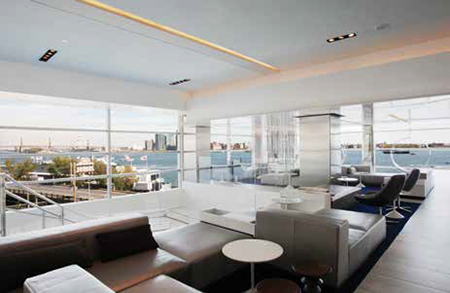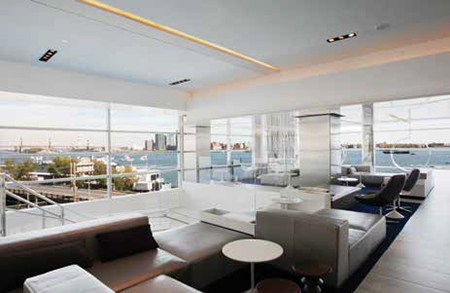To beat out your competition in New York City, you need to bring something unique to the table. When Apella Event Space at Alexandria Center, a sun-filled premium event hosting facility overlooking the East River, decided it was time to upgrade its technology, management knew they needed something bold to make it capable of handling anything its discerning clients could throw at it.

The Apella Event Space is capable of accommodating gatherings of up to 300 people in its facility, which offers arresting views of New York City’s East River. After experiencing a series of failures with its old technology— including complaints about the performance of its projectors in the unusually bright main event room—they brought in Brookings, SD-based integrator, Conference Technologies, to install three Digital Projection 11,000-lumen HIGHlite Laser 1080p projectors.
But they didn’t stop there. To handle the demands of the wide array of events held in the space, which range from science and medical presentations to wedding receptions for up to 300 people, they decided to bump up the control to a broadcast-grade system.
“The first thing was, this needs to be very robust,” said Trent Slyter, AV systems integrator at Conference Technologies. “We all say that in our business, but there’s a difference between robust in a conference room used for internal meetings, and robust for a space that someone’s paying tens of thousands of dollars an hour to be in. So my initial thought was let’s look at more of a broadcast-level system versus a conference-level system. So we went with a broadcast front end, as far as the switching and the transport is HD-SVI, versus HDMI and VGA, and things like that. And it was all toward the end goal that this thing has got to run, and run, and run, and run, and run, and never go down. And so far it has.”
The strain of running equipment nonstop was also a key consideration in the push for a laser projection system. According to Apella’s director of technology, Jamie Denbeck, the facility’s tightly booked schedule requires the projectors to be in use from 40 to 60 hours per week. With typical bulb-driven projectors, this level of taxation would have resulted in quickly deteriorated image brightness, even with very highlumen devices. “The laser projectors can run nonstop for several years,” Denbeck said. “In fact, they’re not even sure how long they might last; the technology hasn’t been around long enough to find out.”
Beyond the concerns of reliability, the upgrades to the control system were done out of the desire to future-proof the facility for the increased demand for BYOD applications. “We went with an HD-SDI production switcher, because at some meetings they have as many as half a dozen different laptops that they want to be able to switch to on the fly,” said Slyter. “They have three screens in there, they wanted the ability to put a different laptop on any screen, on the fly. And when you’re in that environment and people are saying ‘No, put this one up; oh no, I need this PowerPoint,’ you really have to be able to switch that with something other than a touchpanel.”
In order to accommodate the more potent switching, Conference Technologies also had to upgrade the facility’s Crestron infrastructure to a more powerful DigitalMedia 8G+ system, as well. So now the event space, which is also equipped with a pair of Tandberg HD videoconferencing cameras, can smoothly accommodate all of the technology its tech-savvy clientele could want.
But the facility also hosts events that only want to utilize the space for its stylish modern aesthetics and beguiling river views. “Another concern was for events that require no technology, they didn’t want to see any technology,” said Slyter. “So that’s why the whole control system is mobile; it disconnects with three or four HD-SDI cables, packs up into itself and rolls away, all of the projectors recess in to the ceiling, and the screens go back up into the ceiling.”
Ultimately, however, the robustness and durability of the facility’s technology has allowed it to offer an additional advantage over competing event spaces. “We offer our clients complimentary use of our projectors,” said Denbeck. “Typically you have to pay extra for that. So it’s a huge selling point.”
Matt Pruznick is associate editor of SCN and Residential Systems. Follow him on Twitter @Pruznick.

